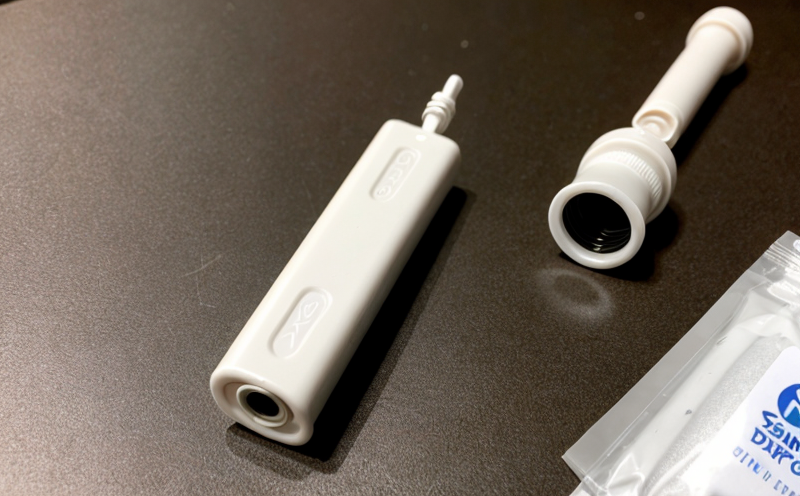Catheter Balloon Burst Pressure Testing
The catheter balloon burst pressure test is a critical procedure in ensuring the safety and reliability of medical devices, particularly those that are disposable or single-use. This test evaluates the integrity and durability of the balloon component within a catheter to withstand specified pressures without failure. The test is essential for compliance with international standards such as ISO 10993-1 and IEC 60601-2-2, which mandate that medical devices meet specific safety requirements.
The process involves subjecting the balloon component of a catheter to increasing pressure until it bursts. This burst point is then measured with precision to ensure it falls within specified limits set by regulatory bodies and manufacturers. The test setup typically includes specialized equipment designed to apply controlled pressure in an environment that simulates real-world conditions.
Proper specimen preparation is critical for accurate testing results. Prior to testing, the catheter balloon must be thoroughly cleaned and inspected to ensure there are no pre-existing defects or damage. Once prepared, the balloon is mounted onto a testing fixture. The fixture then connects the balloon to a pressure application system capable of delivering precise increments of pressure.
The test begins with applying low-pressure increments until the balloon shows signs of impending failure. At this point, the exact pressure value at which failure occurs is recorded and compared against predefined specifications. This data is crucial for quality assurance and helps ensure that each catheter meets safety and performance standards before being released to market.
For single-use devices like catheters, consistent testing ensures reliability and patient safety. By adhering strictly to established protocols, laboratories can provide accurate measurements of burst pressures which are vital for regulatory approval processes. This service not only enhances product quality but also contributes significantly towards protecting public health by preventing potentially dangerous failures in medical procedures.
The catheter balloon burst pressure test plays a pivotal role in maintaining high standards across the healthcare industry. Its importance cannot be overstated as it directly impacts patient safety and overall device performance. Employing this rigorous testing procedure ensures that only safe, effective products reach clinical use, thereby fostering trust between manufacturers, regulators, and end-users.
Why It Matters
The catheter balloon burst pressure test is crucial for ensuring the safety and efficacy of medical devices. By subjecting the balloon component to controlled pressure until failure occurs, this test provides valuable insights into the product's structural integrity under stress conditions similar to those encountered during use.
- Ensures compliance with regulatory standards
- Guarantees consistent quality across batches
- Reduces risks associated with device failure during critical procedures
- Enhances overall trust in the medical community towards the manufacturer's products
The accuracy and reliability of these tests contribute significantly to reducing adverse events related to medical devices. When performed correctly, they provide a robust foundation for ensuring that each catheter meets stringent quality control criteria before being made available to healthcare providers.
Moreover, consistent adherence to such testing procedures helps maintain the reputation of both manufacturers and their products within the competitive landscape. By demonstrating commitment to safety and excellence in production processes, companies can build a strong brand identity that resonates positively with consumers and stakeholders alike.
Environmental and Sustainability Contributions
The catheter balloon burst pressure test contributes positively to environmental sustainability efforts by ensuring that medical devices are both safe and efficient in their intended applications. By eliminating substandard or faulty products early in the manufacturing process, this testing procedure helps reduce waste associated with defective items reaching end-users.
Furthermore, accurate and reliable testing facilitates the development of more durable and effective single-use devices, which ultimately leads to reduced resource consumption throughout the product lifecycle. This contributes towards minimizing ecological footprints while enhancing user satisfaction through dependable performance.
Manufacturers who invest in thorough quality assurance programs like catheter balloon burst pressure tests demonstrate their commitment to sustainable practices. Such initiatives not only benefit the environment but also contribute positively to corporate social responsibility (CSR) objectives, fostering goodwill among consumers and industry partners alike.
Competitive Advantage and Market Impact
- Ensures compliance with international standards such as ISO 10993-1 and IEC 60601-2-2
- Guarantees consistent quality across all batches produced
- Reduces risks associated with device failure during critical medical procedures
- Enhances overall trust in the medical community towards manufacturer's products
The catheter balloon burst pressure test provides a competitive edge by ensuring that only safe, effective devices reach market. Compliance with these stringent testing protocols not only builds brand reputation but also opens doors to new markets where regulatory requirements are increasingly stringent.
By consistently delivering high-quality products through rigorous quality assurance measures, manufacturers can differentiate themselves from competitors and establish a strong foothold in the competitive medical device industry. The ability to demonstrate adherence to international standards becomes an attractive selling point for healthcare providers looking for reliable solutions that meet regulatory expectations.





